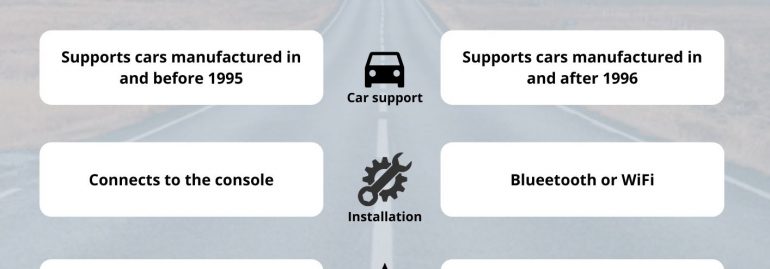If you are wondering, what is the OBD? OBD stands for on-board diagnostics. This computer-based system controls and monitors major engine components and is a requirement for vehicles in the USA and Europe. It also helps prevent engine failures through a standardised set of diagnostic trouble codes. To learn more about this system, read this article. Here are some of the benefits of OBD:
OBD stands for On-Board Diagnostics
The term “OBD” refers to on-board diagnostics. This electronic system is built into almost every part of a car and helps to keep emission levels at a safe level. Using a computer to analyze the information it receives, it can monitor different aspects of a car’s operation, such as fuel efficiency and GPS location. It can also diagnose major faults, such as an oil leak or an ignition problem.
The OBD system communicates with the rest of the vehicle’s systems, including the engine, transmission, and emissions system. By reading data from sensors, the system can determine if anything is wrong and should be fixed. OBD can also warn you of a looming problem before it becomes too severe, as it can trigger a warning light on your instrument panel. This feature is available on many cars, including those made after 1996.
Since OBD was first introduced, the system has undergone major changes. Originally, it only monitored the engine and its emissions, so it would only notify the driver of an MIL problem, not store it inside the system. As cars became more advanced, the number of sensors and information stored inside the system increased. Consequently, the number of cars with OBD systems was increased, enabling the system to monitor all aspects of a car.
It’s a computer-based system designed to reduce emissions by monitoring the performance of major engine components
The On-Board Diagnostics (OBD) system is a critical part of any modern vehicle. The system communicates with the ECU to monitor the performance of major engine components. It has evolved a great deal since it was first introduced in the 1980s, when it was only used to inform the driver of a malfunction with the MIL. Today, many vehicles are equipped with OBD II, a mandatory requirement since 1996.
OBD monitors the performance of major engine components and warns the driver if something isn’t working properly. It works by evaluating the performance of a vehicle’s catalytic converter based on data from oxygen sensors and exhaust tailpipe emissions. OBD also triggers the MIL when emissions go over a preset threshold. MIL also stores fault information about the catalyst system.
OBD systems are important because they notify the driver if a component needs to be repaired immediately. Taking care of a problem early can save a driver money and prevent costly damage to engine components. The OBD computer will store the Diagnostics Trouble Code, or DTC, in its database. A Check Engine light or Service Engine light will illuminate when a critical component needs repair. Once it illuminates, it cannot be turned off until it is repaired.
OBD is a standard for emission-related information in vehicles. Some vehicles, however, are not equipped with OBD. These cars must meet Euro V and Euro VI emission standards. Currently, the most common model to have an OBD is the Toyota Prius. It uses a standardized communication protocol and SAE J1962 diagnostic link connector.
It uses a standardized series of diagnostic trouble codes
There are two major categories of DTC: generic and manufacturer-controlled. In this classification, the first digit is a digit, while the second identifies the subsystem of the code. In addition, the manufacturer-controlled DTCs are called B2xxxx codes, while generic DTCs are called C2xxx codes. These codes are used to diagnose problems related to mechanical, electrical, and networking systems of a vehicle. The DTC format is defined in a document titled SAE J2012DA, which describes a standardized set of DTCs. In addition, the document specifies ranges for vehicle manufacturer-specific usage.
The obd code is a standardized series of trouble codes that car manufacturers use to identify various problems in vehicles. Most of the standardized codes use the same procedure for troubleshooting purposes. The first two codes identify the system that is malfunctioning. The remaining three codes relate to the powertrain. The powertrain includes the engine, transmission, and emissions systems. While these are the most common problems cited, they’re not the only cause of misfiring. The best way to determine the cause of a misfiring engine code is to visit a professional mechanic.
A code reader has the ability to access OBD2 and J1939 compliant vehicles. To check if your car is compliant, consult your owner’s manual or contact your vehicle dealership. Various DTC codes are common and can occur for many reasons. Not all of them, however, require immediate attention. However, the critical ones should be dealt with immediately. If not addressed correctly, the car could cause severe damage to the driver and the surrounding area.
It’s a vehicle compatibility tool
Using a vehicle compatibility tool can save you time and money. Before, you had to spend a lot of time researching and inputting fitment information. With the advent of online compatibility databases, you can do all of this in seconds. But that’s not the only advantage of online compatibility tools. The ease and convenience of using them also make them useful for those who need to find replacement parts quickly.
eBay sellers who sell auto parts on their website can specify vehicle compatibility by uploading a product catalog. This tool already contains information about auto parts, but the product catalog has its limitations. For example, not all parts are listed in detail. Also, not all parts are available in all countries. This tool can help you avoid wasting time on search engines looking for a certain part. And if your parts are available for your vehicle in one country but in another, the product catalog isn’t very helpful.


